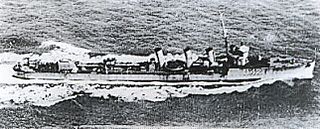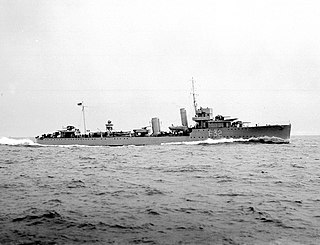Related Research Articles

HMS Bat was a Palmer-built three funnel, 30 knot torpedo boat destroyer ordered by the Royal Navy under the 1895 – 1896 Naval Estimates. She was the third ship to carry this name since it was introduced in 1815 for a revenue cutter in service until 1848. Bat was classified along with similar vessels as a C-class destroyer in 1913.
Three ships of the Royal Navy have been called HMS Raider.
Three ships of the Royal Navy have borne the name HMS Battleaxe:
Three ships of the Royal Navy have been named HMS Onslow:
Five ships of the Royal Navy and an air station of the Royal Naval Air Service have borne the name HMS Landrail, another name for the bird more commonly named a corn crake:
HMS Waterwitch has been the name of several Royal Navy vessels:
Ten ships of the Royal Navy have been named HMS Scourge :
Several ships of the British Royal Navy have been named HMS Partridge, after the bird.
Nine ships of the Royal Navy have borne the name HMS Speedy:
Twelve ships of the Royal Navy have been named HMS Otter, for the otter.
Eight vessels of the Royal Navy have borne the name HMS Manly.
Five ships of the Royal Navy have carried the name HMS Handy:
Several ships of the Royal Navy have been named HMS Fairy:

HMS Pasley was an Admiralty M-class destroyer built on the Tyne by Swan Hunter & Wigham Richardson for the Royal Navy and launched on 15 April 1916. She saw service during the First World War.
The first HMS Walrus (D24) was a W-class destroyer of the British Royal Navy that saw service in the final months of World War I.

The first HMS Wessex (D43) was a W-class destroyer of the British Royal Navy that saw service in the final months of World War I and the early months of World War II.
Three ships of the Royal Navy have borne the name HMS Newark, after the town Newark-on-Trent:
At least three ships of the Royal Navy have borne the name HMS Sarpedon. They are named after Sarpedon, a Greek hero and son of Zeus.
There have been three ships of the Royal Navy named HMS Redgauntlet after the novel by Sir Walter Scott:

HMS Paladin was a Admiralty M-class destroyer which served with the Royal Navy during the First World War. The M class were an improvement on the previous L-class destroyer, capable of higher speed. Launched on 27 March 1916. Paladin took part in the Royal Navy sorties against German minesweepers in 1917, which culminated in the Second Battle of Heligoland Bight on 17 November, although the destroyer did not engage with any enemy warships during the battle. After the end of the war, the ship was placed in reserve before being decommissioned and sold to be broken up on 9 May 1921.